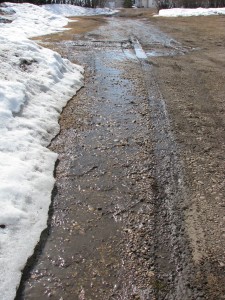The weather was gorgeous yesterday. I spent the warm sunny afternoon pulling grass roots out of the garden bed next to the south wall of my house. Some always manage to sneak in underneath the mulch and plants during the summer, and the first I see of them is the following spring, when little bunches of busily photosynthesizing leaves appear before anything else in the whole yard is green.
It was wonderful to get my fingers in the soil and do something outside after having a nasty cold for two weeks. I encountered some busy wood bugs, an active earthworm, and a nice shiny black beetle.
Now, I know that the microclimate right next to my house is fantastically warm (also dry, because it’s under the eaves), but this is not a story I should be able to tell in mid March near Edmonton. I took this picture of my driveway on April 10, 2011: This year, a month earlier, there’s no snow unless it falls overnight, and my garden critters are waking up. I put a nice thick fresh layer of mulch on my freshly weeded bed next to the house, because I’m not ready to plant anything there yet, and if we get the big blizzard that I’m halfway hoping for at Easter the critters will need the blanket. 🙂
This year, a month earlier, there’s no snow unless it falls overnight, and my garden critters are waking up. I put a nice thick fresh layer of mulch on my freshly weeded bed next to the house, because I’m not ready to plant anything there yet, and if we get the big blizzard that I’m halfway hoping for at Easter the critters will need the blanket. 🙂
This amazing resource was recently shared on the Edmonton Permaculture Facebook group:
Alberta’s Natural Subregions Under a Changing Climate: Past, Present and Future
Sherwood Botsford (of Sherwood’s Forests) summed it up, for those of us in the group not up to reading the entire paper:
“The paper above has some pretty heavy sledding in it, but if you are serious about permaculture, you MUST read this.
TLDR:
A: By 2080 Alberta will be roughly 6 degrees warmer than today in the Business as usual model.
B: Overall we get more precip, but the extra comes in winter, not summer. We average an overall drier climate. (More rain, but even more evaporation.)
C: Lethbridge’s climate extends to Slave Lake. Lethbridge itself will be like drier parts of Wyoming. Much of what is currently Aspen Parkland and Boreal Forest becomes dry mixed grass prairie.
What does this mean for you:
Water becomes critical in a way that to now it wasn’t. Go back to the books and study desert systems. We won’t quite be a desert, but water will be the limiting factor for growing lots of things.
If you need to put in a well, put it in deep.
Look at runoff storage systems. Ponds, dugouts. Make them as deep as your equipment can handle.”
I guess I’d better start re-reading Brad Lancaster’s Rainwater Harvesting for Drylands and Beyond (short taste here).
Mark Shepard (author of Restoration Agriculture; there’s a nice long YouTube talk by him here) emphasizes looking at existing and past plant communities of your region when choosing plants to incorporate into permaculture systems. The Alberta government has put together a fantastic series of free pdf documents that essentially catalogue plant communities in the different bioregions of Alberta which you can access here. It’s geared to grazing, but the information is invaluable when trying to get an idea of vegetation types that might be more comfortable here as conditions change.
I’m really proud to be part of a movement where folks don’t throw up their hands in despair, but look for ways to make systems that will continue to support us as our world gets more unpredictable. Please let me know if you come up with more resources to help with the planning, and good luck in all your designs!